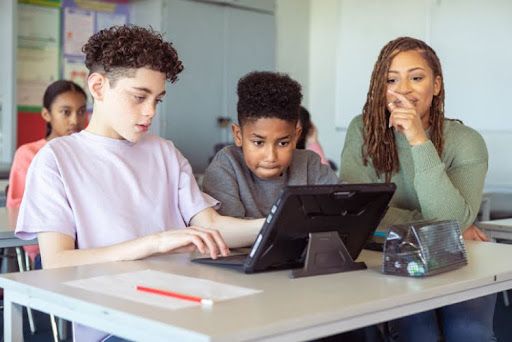Proponents of using digital technology in schools believe it is the future of education. They say it can lower costs and improve the quality of education. But some people argue that children spend too much time on screens, which affects their well-being.
The debate continues, but digital technology is already a crucial component of K-12 education. According to the Institute of Education Sciences, 94 percent of public schools give students digital devices.
Digital technology powers new learning approaches, including blended learning. So, what is blended learning? Blended learning is an educational approach that allows teachers to leverage both worlds: traditional classroom teaching and technology. Blended learning goes beyond adding technology as a tool for learning. It is an approach that incorporates technology into lesson plans.
Blended Learning: Definition
Understanding what blended learning is requires knowing what it is not. Blended learning doesn’t try to replace teachers with computers. The truth is that teachers play a critical role in blended learning environments.
The blended learning approach helps teachers make education more interactive, flexible and individualized. It combines traditional classroom teaching with internet-based methods.
In blended learning, students learn from their teacher in a regular classroom. Students also get to collaborate with their classmates in the school. Blended learning extends this learning to the internet.
Blended Learning: Benefits vs. Drawbacks
Blended learning offers advantages and disadvantages. The primary benefits include flexibility, personalization, engagement and accessibility.
- Flexibility: Blended learning lets students work independently, which suits each student’s different schedule and preferences.
- Personalization: Blended learning allows each student to work on content created just for them, based on their individual needs, strengths and weaknesses.
- Engagement: Interactive online activities are designed to make learning fun and personalized, and to increase students’ engagement.
- Accessibility: Online resources can help students learn better, because they can study and use materials whenever and wherever they choose.
- Analytics: Learning platforms provide detailed information on each student’s performance on tests and assignments. Teachers can use this data to see how students are doing and what they need help with.
Blended learning has some drawbacks, too. These include technical challenges, limited face-to-face interactions, teacher training needs and motivation challenges.
- Technical challenges: Students and teachers may face challenges with internet access, which can disrupt learning. They also may need help with technical issues.
- Limited face-to-face interaction: Limited in-person contact with teachers can hinder some students’ development of the important social and communication skills needed for a well-rounded education.
- Teacher training: Teachers may require additional training to use the technology, which can be time consuming and costly.
- Sustaining motivation: Digital tools may not be enough to keep students engaged. Regular interaction in the classroom is needed to motivate students and promote active learning.
5 Blended Learning Models
Blended learning offers diverse features and benefits, including catering to the specific needs of students and educators. By merging in-person teaching with online resources, blended learning can enhance engagement, personalization and flexibility.
1. Rotation Model
Rotation in blended learning involves students moving through different learning stations or activities. Students can learn at their own pace and explore different perspectives using these rotations. The rotation model also provides varied learning experiences.
Station Rotation
Station rotation creates structured learning environments. It combines teacher-led small group work with student-controlled, online-paced learning. This method helps students adapt, with students given a set amount of time at each station before they transition. The online components complement the in-person teaching.
Whole Group Rotation
With whole group rotation, the entire class moves between activities, following a schedule set by the teacher. In the past, students would go to a school lab. Now, with nearly every student in many schools having their own device, the teacher can easily switch between online and offline tasks without moving the students.
Individual Rotation
With individual rotation, students move to different stations based on their own schedules. This approach helps students concentrate on learning activities customized just for them. This can help improve their involvement with and comprehension of the material.
2. Flipped Classroom Model
The flipped classroom is designed to engage students, promote deep learning and enhance individualized instruction. The name of this instructional model comes from the fact that it flips traditional teaching methods. Students learn new content at home using prerecorded videos or online resources. In the classroom, the teacher guides students through discussions and activities to help them engage with and apply what they watched or read at home.
This approach centers on active learning, which can help students understand content more deeply and develop more complex ideas. Flipped classrooms with collaborative environments can help improve students’ intrapersonal and interpersonal skills.
3. Flex Model
The flex model enables students to learn independently while they explore their personal interests. Autonomy is key in this model, which emphasizes flexibility and student choice. Students can choose when, where and how they access educational content and resources. Students can learn in different environments because they have access to digital resources. Students are not typically required to attend a physical classroom. However, teachers guide and support students’ educational journey.
4. A la Carte Model
The a la carte model combines online learning and classroom education for a balanced approach. Students can use online courses for their chosen subjects. They get benefits like being able to set their own pace and access a range of digital resources, just like in the flex model. The primary difference is that in the a la carte model, traditional classroom-based education is required.
5. Enriched Virtual Model
In the enriched virtual model, students attend regular classes, but they learn most of the content outside of the classroom. It is common for students only to need to show up to class a few times per week. This model is like the flex model because it focuses on online and self-paced learning. It differs because it has in-person components and follows a fixed schedule. For example, students could take online courses, but they would still need to do in-person assessments.
Strategies for Creating Effective Blended Learning Programs
Student engagement is key to a successful blended learning program. Therefore, ensuring the effectiveness of blended learning means finding ways to boost students’ engagement. The following strategies can help teachers create an effective blended learning program:
- Prioritize student-centered learning: To create strong bonds between teachers and students, teachers need to prioritize and focus on the needs of their students. This also helps create an environment in which active participation and engagement are encouraged.
- Set clear expectations: Clear communication and expectations are crucial. To help students focus on learning, teachers should ensure they understand the course goals and exactly how their learning time will be structured, especially when using new models.
- Choose the appropriate blended learning model: Teachers need to decide what they want to achieve with blended learning and choose the model that best fits their goals. Certain models may require specific tools and classroom designs.
- Provide collaboration tools: Collaboration is an integral part of blended learning. Teachers must provide the tools and opportunities that their students need for group work and project learning, using platforms that help groups collaborate.
- Create interactive resources: Teachers should regularly engage their students with quizzes, online games and gamified learning platforms to engage the students and promote active learning.
Empower Every Learner
Blended learning can help promote interactivity, collaboration and the use of interactive resources. For many teachers, this approach can lead the way in shaping personalized and effective learning for students. This means that educators should stay updated on the latest approaches in the areas of classroom management, teaching theory, assessment analysis and curriculum creation to be able to prepare their classrooms for the future.
With a curriculum that fosters inclusive and student-focused learning environments, Augusta University Online’s Master of Education in Instruction program can prepare teachers with the knowledge and applicable tools they need to empower every learner.
Learn more about Augusta University Online’s MEd program.
Recommended Readings
What Is Pedagogy in Education?
5 Tips for Creating an Inclusive Learning Environment
Sources:
Brookings, “Flipped Learning: What Is It, and When Is It Effective?”
Cureus, “Effects of Excessive Screen Time on Child Development: An Updated Review and Strategies for Management”
EducationWeek, “Students Are Behaving Badly in Class. Excessive Screen Time Might Be to Blame”
Edutopia, “To Increase Student Engagement, Focus on Motivation”
Fierce Education, “7 Practical Ways to Create Effective Blended Learning”
ICEV, “Top 7 Blended Learning Strategies for CTE”
Institute of Education Sciences, School Pulse Panel
ISpring, “What Is Blended Learning? Examples, Types and More”
LearnUpon, “What Is Blended Learning?”
National Education Association, Rethinking the Classroom for Blended Learning
 Augusta University
Augusta University




